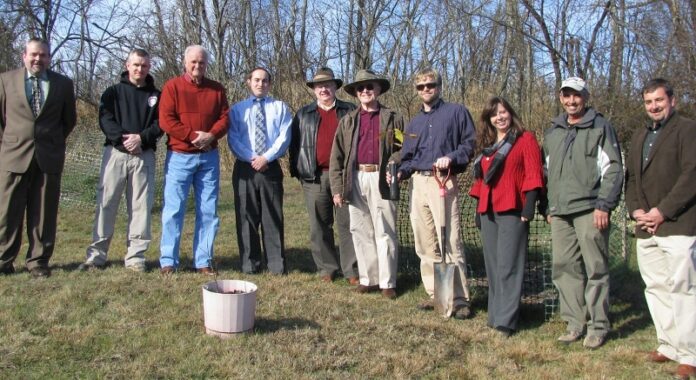
On November 19, 2013, representatives from Senator Tim Kaine’s office from Patrick and Floyd Counties, and from both The American Chestnut Foundation (TACF) and the Dan River Basin Association joined Directors of Blue Ridge Heritage, Inc. (BRHI) to plant two 15/16ths American chestnut hybrid trees on the BRHI property in the Rocky Knob area of Floyd and Patrick Counties.
One of the trees was donated to BRHI in memory of previous owner Mr. Bramley by his family; the other was donated by TACF. Last spring, 100 percent American chestnut saplings were planted to test soil and exposure locations in preparation for the introduction of the hybrid (blight-resistant) chestnut trees that will be gradually introduced to the site over the coming decades, in partnership with TACF. Of those ~30 American chestnut saplings planted 6 months ago, approximately 10 have survived, and organizers hope they will continue to grow.
As a test crop, those trees that take hold should survive until the blight undermines them at about 15 years old, offering valuable information to guide the future planting of the Restoration chestnut grove.
“Part of Blue Ridge Heritage’s long-term plan,” says Steve Swartz, President of BRHI, “is to have a grove of these 15/16ths American, hybrid, Restoration chestnuts from The American Chestnut Foundation growing on this property for visitors to walk through. Our mission is to educate residents and visitors about 20th century life in these two counties, so our goal with this nascent Chestnut Program is to help us all understand what the loss of the chestnuts during the 20th century meant to the economies and culture of Floyd and Patrick Counties. In addition, it is meaningful for us all to understand more about the effort to restore the chestnut in America; and to experience some of the results of that effort.”
“These trees, which are 15/16ths American chestnut, represent 6 or 7 generations of back-crossing the American chestnut with blight-resistant oriental chestnut trees,” Matt Brinckman explains. “With each generation, we have ‘challenged’ the saplings with the blight, which means: we inject them with the blight. Those trees that survive the challenge are allowed to produce seed for the next generation, which is carefully crossed again with the native American chestnut.
“TACF has been working on this hybrid strain for decades, and we hope each tree sprouted from these nuts will be blight-resistant. We cannot be sure, however, that this is the final strain,” he cautions. “These are a test generation, and by planting them here today, their ability to survive the stressors to which they are subject, if they do not survive, will be important data for our research.”
The planting took place after introductions and a question and answer session. Collins, Haworth, and Swartz planted one of the saplings; while Turman (Joe), Rose, and Brinckman planted the other. The guests participated in watering, fencing, and other details while networking and chatting amongst themselves.


